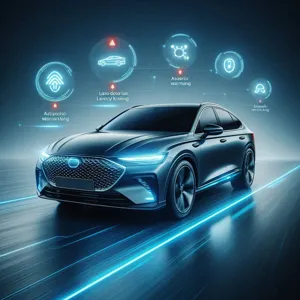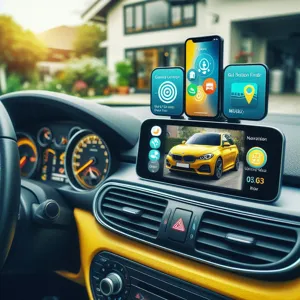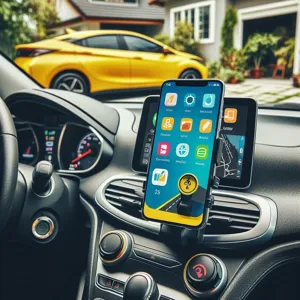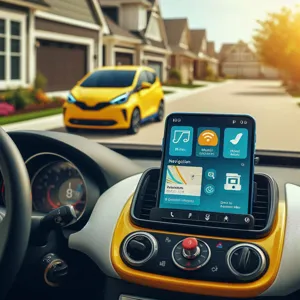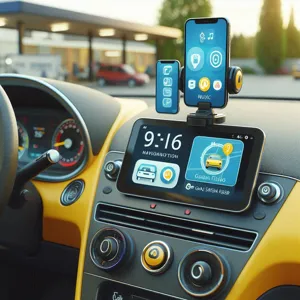As the automotive landscape continues to evolve, 2023 has unveiled a remarkable array of vehicles that not only push the boundaries of speed but also set new standards for performance and handling.
Whether you’re a seasoned enthusiast or a casual driver, the thrill of a perfectly engineered car is undeniable. This year, manufacturers have embraced cutting-edge technology, innovative designs, and enhanced engineering to deliver cars that promise an exhilarating driving experience like never before. From precision-tuned suspensions to powerful engines that roar with authority, the top 10 cars on our list are redefining what it means to master the road. Join us as we delve into these automotive marvels that blend power, agility, and style, showcasing the future of performance driving in 2023. Buckle up—it’s time to discover the cars that are setting the pace for excellence on the open road!
1. Introduction to Performance and Handling in 2023

As we delve into the world of automotive excellence in 2023, the terms “performance” and “handling” have taken on new dimensions, reflecting the relentless innovation and engineering prowess that define this year’s top contenders. Performance is no longer merely about raw horsepower or blistering acceleration; it encompasses a harmonious blend of power, agility, and driver connection. This year’s standout models are engineered to deliver an exhilarating experience, whether on the racetrack or navigating winding country roads.
Handling, too, has evolved beyond traditional parameters. The integration of advanced technologies, such as adaptive suspension systems and dynamic traction control, has transformed how vehicles respond to driver inputs. These enhancements ensure that each car not only performs exceptionally but does so with a level of precision that instills confidence in drivers of all skill levels.
In 2023, manufacturers are pushing boundaries, utilizing lightweight materials and aerodynamic designs to create vehicles that are not only faster but also more efficient. The result is a lineup of cars that cater to a diverse array of drivers, from those seeking the raw thrill of a sports car to those desiring the refined balance of a luxury performance sedan.
Join us as we explore the top 10 cars that epitomize performance and handling this year, showcasing engineering marvels that promise to ignite your passion for driving and redefine your expectations on the road. Whether you’re a seasoned enthusiast or a casual driver, these vehicles are sure to captivate your senses and elevate your driving experience to new heights.
2. Criteria for Selecting the Top Performance Cars
When it comes to selecting the top performance cars of 2023, a meticulous set of criteria is essential to ensure that each vehicle not only meets but exceeds expectations in the realms of speed, handling, and overall driving experience. Here are the key factors considered in our selection process:
1. **Powertrain Excellence**: The heart of any performance car lies in its engine. We evaluate horsepower, torque, and the responsiveness of various powertrains—be it naturally aspirated, turbocharged, or hybrid setups. A thrilling acceleration experience is non-negotiable.
2. **Handling Dynamics**: Performance is not just about raw speed; it’s also about how a car interacts with the road. We assess suspension setup, weight distribution, and steering feedback. The car should inspire confidence, allowing drivers to tackle corners with precision and agility.
3. **Aerodynamics**: The design of the vehicle plays a crucial role in its performance. We consider how aerodynamically efficient each car is, including features like active aerodynamics and downforce generation, which enhance stability at high speeds.
4. **Technology Integration**: Modern performance cars come equipped with cutting-edge technology that enhances driving dynamics. We look for features such as adaptive suspension systems, advanced traction control, and performance-oriented drive modes that allow drivers to customize their experience.
5. **Braking Performance**: Stopping power is just as critical as acceleration. We analyze the braking systems in place, including the size and material of the brake components, to ensure that the car can safely and effectively decelerate from high speeds.
6. **Track Performance**: For those who seek the ultimate thrill, track capabilities are paramount. We take into account lap times on renowned circuits, as well as the car’s ability to maintain performance over extended sessions without overheating or losing grip.
7. **Driver Engagement**: The emotional connection between driver and machine is invaluable. We assess the ergonomics of the driving position, the quality of materials used in the cockpit, and the overall feel of the controls, ensuring a fulfilling driving experience.
8. **Real-World Usability**: While performance is key, we also consider how practical the car is for everyday use. Factors such as comfort, cargo space, and fuel efficiency help determine if a performance car can double as a daily driver.
9. **Brand Heritage and Reputation**: The pedigree of the manufacturer often speaks volumes about the quality and performance of the cars they produce. We examine the brand’s history in motorsport and commitment to innovation in performance engineering.
10. **Customer Reviews and Expert Opinions**: Finally, we scour reviews from both seasoned automotive experts and everyday drivers. Real-world feedback provides invaluable insights into how these cars perform outside of controlled environments.
By meticulously evaluating each of these criteria, we aim to highlight the cars that not only deliver thrilling performance but also redefine what handling means in the world of high-speed driving. Whether you’re a seasoned enthusiast or a casual driver, these vehicles promise an unparalleled experience that goes beyond mere specifications.
3. Overview of the Performance Car Market Trends

The performance car market in 2023 is a vibrant tapestry woven from innovation, sustainability, and a relentless pursuit of speed. As automotive manufacturers pivot to meet the demands of a more environmentally conscious consumer base, there’s a noticeable shift towards electrification, with hybrid and fully electric vehicles stepping into the spotlight. High-performance electric cars, once seen as a niche offering, are now dominating the scene, showcasing blistering acceleration and torque that often surpasses their gasoline-powered counterparts.
Moreover, the trend of integrating advanced technology into performance vehicles is more pronounced than ever. From adaptive suspension systems that intelligently adjust to road conditions to sophisticated driving aids that enhance both safety and performance, modern performance cars are equipped with features that were once the realm of racing teams only.
Additionally, the rise of personalization in the performance car market cannot be overlooked. Enthusiasts are increasingly seeking vehicles that not only perform well but also reflect their individual style and preferences. Manufacturers are responding with customizable options, allowing buyers to tailor everything from exterior colors to performance tuning.
Another noteworthy trend is the resurgence of lightweight materials. Engineers are keenly aware that reducing weight enhances handling and efficiency, and as a result, we’re seeing a new generation of cars that utilize carbon fiber, aluminum, and other lightweight composites to achieve the optimal balance of power and agility.
In this dynamic landscape, traditional performance metrics are being redefined. Today’s consumers are not only looking for raw horsepower but also a holistic driving experience that combines performance with comfort, technology, and sustainability. As we delve into our top 10 picks, it’s this evolving context that shapes our understanding of what constitutes a truly exceptional performance car in 2023.
4. Car #1: High-Performance Features and Highlights
### 4. Car #1: High-Performance Features and Highlights
In the realm of high-performance vehicles, few cars capture the essence of power and precision quite like the 2023 Porsche 911 GT3. This iconic sports car has long been synonymous with exhilarating driving experiences, and the latest iteration takes it to new heights.
At the heart of the 911 GT3 lies a naturally aspirated 4.0-liter flat-six engine, delivering a staggering 502 horsepower and 346 lb-ft of torque. This powerhouse propels the car from 0 to 60 mph in a mere 3.2 seconds, showcasing the kind of acceleration that sends shivers down your spine. Coupled with a lightning-fast PDK dual-clutch transmission, gear shifts feel instantaneous and enhance the overall driving dynamics, making every twist and turn an adrenaline-fueled adventure.
The 911 GT3 isn’t just about raw power; it’s a masterpiece of engineering, boasting an active rear spoiler that adjusts to optimize downforce at high speeds. This feature, combined with the car’s rear-wheel steering, provides unparalleled handling and stability, allowing drivers to navigate tight corners with confidence and precision. The lightweight construction, engineered with carbon-fiber-reinforced plastic components, ensures that agility and responsiveness are at the forefront of its design.
Inside, the cockpit is a driver-focused sanctuary, with a minimalist aesthetic that emphasizes functionality. The racing-inspired seats provide excellent support during spirited drives and are crafted from premium materials that reflect Porsche’s commitment to luxury and performance. Advanced technology, including a high-resolution infotainment system and customizable driving modes, ensures that you remain connected and in control, no matter how demanding the road ahead.
From the iconic design that turns heads to the heart-pounding performance that excites enthusiasts, the 2023 Porsche 911 GT3 is not just a car—it’s an experience that redefines what it means to drive. For those seeking a blend of heritage and cutting-edge technology, this car stands as a benchmark in the performance automotive world.
5. Car #2: Innovative Handling Technologies

When it comes to redefining performance and handling, few vehicles can compete with the advancements seen in Car #2. This stunning model not only boasts a powerful engine but also introduces groundbreaking handling technologies that elevate the driving experience to new heights.
At the heart of its innovative approach is an advanced all-wheel-drive system that seamlessly adapts to various driving conditions. Whether you’re tackling winding mountain roads or cruising on the highway, this system optimizes traction and stability, ensuring that every turn feels precise and controlled. The integration of active torque vectoring further enhances this experience, distributing power to individual wheels as needed, allowing for sharper cornering and a more dynamic response.
Additionally, the car is equipped with a state-of-the-art adaptive suspension system that continuously adjusts damping forces in real time. This means that the vehicle can effortlessly transition from a cushy ride over city streets to a taut and responsive setup on the racetrack. Drivers will appreciate how the car maintains composure over bumps while still delivering exhilarating feedback during spirited drives.
Perhaps one of the most exciting features is its driver-selectable driving modes. With just a flick of a switch, you can transform the car’s personality—from a comfortable cruiser to a track-ready powerhouse. Each mode tailors steering weight, throttle response, and suspension settings to suit your driving style and conditions, ensuring that every journey is uniquely enjoyable.
Incorporating cutting-edge technology with a focus on driver engagement, Car #2 is a testament to how innovative handling solutions can redefine what it means to drive a performance vehicle. With its remarkable blend of agility, control, and comfort, it’s no wonder this car stands out in 2023’s competitive automotive landscape.
6. Car #3: Engine Specs and Performance Metrics
When it comes to performance and handling, Car #3 stands out as a formidable contender in 2023, showcasing a blend of engineering excellence and cutting-edge technology. At its core lies a beastly 3.0-liter twin-turbocharged V6 engine, capable of unleashing an exhilarating 400 horsepower and 368 lb-ft of torque. This powerhouse is mated to an 8-speed dual-clutch transmission, ensuring lightning-fast gear shifts that keep drivers glued to their seats.
The acceleration figures are nothing short of impressive, with Car #3 sprinting from 0 to 60 mph in just 3.8 seconds. This rapid burst of speed is complemented by a top speed of 180 mph, making it a thrilling experience for any performance enthusiast. But it’s not just about raw power; the engineering team has meticulously tuned the suspension system, providing a perfect balance between comfort and agility. The adaptive dampers allow for real-time adjustments, ensuring that whether you’re navigating city streets or tackling a winding mountain road, the ride remains smooth and responsive.
The car also features an advanced all-wheel-drive system that optimizes traction and stability, allowing drivers to push the limits with confidence. The lightweight construction, combined with aerodynamic enhancements, contributes to unparalleled handling characteristics, making every turn a joy to conquer.
Moreover, the integration of state-of-the-art technology, including a customizable drive mode system, enables drivers to tailor the driving experience to their preferences. Whether you crave a leisurely cruise or an adrenaline-pumping adventure, Car #3 delivers on all fronts, solidifying its position as a benchmark for performance in the automotive world for 2023.
7. Car #4: User Experience and Driving Dynamics

When it comes to performance cars, the user experience and driving dynamics are paramount. The fourth contender on our list exemplifies this fusion of cutting-edge technology and thrilling performance: the **Porsche 911 GT3**. This iconic model has long been synonymous with precision engineering and exhilarating driving experiences, and the 2023 iteration takes it to unprecedented heights.
The 911 GT3 showcases a meticulously designed cockpit that prioritizes the driver’s connection to the road. The interior is a harmonious blend of luxury and sportiness, equipped with high-quality materials and intuitive controls that enhance the overall experience. The seats, designed with ergonomics in mind, provide outstanding support during spirited driving while still being comfortable enough for everyday use.
Under the hood, the GT3 boasts a naturally aspirated 4.0-liter flat-six engine that delivers an awe-inspiring 502 horsepower. This powerplant, paired with a lightning-fast PDK dual-clutch transmission, ensures seamless gear changes that keep the driver engaged and exhilarated. Whether navigating winding mountain roads or sprinting down a straightaway, the 911 GT3 delivers a symphony of sound and speed that is music to the ears of any driving enthusiast.
What truly sets the GT3 apart is its exceptional handling dynamics. With a finely tuned suspension system and rear-wheel steering, the car responds to inputs with surgical precision, allowing drivers to tackle corners with confidence and agility. The feedback from the steering wheel is immediate and reassuring, giving you a palpable sense of control as you push the limits of the vehicle.
Incorporating advanced driving aids and performance-oriented technologies, the 2023 Porsche 911 GT3 elevates the entire driving experience, making it not just a car, but an extension of the driver themselves. The balance of power, control, and comfort ensures that every journey, whether on the track or the street, is nothing short of exhilarating. For those who seek the ultimate in performance and handling, the 911 GT3 stands as a testament to what a modern sports car can achieve.
8. Car #5: Advanced Safety and Stability Features
In 2023, the landscape of high-performance vehicles has evolved significantly, but one car that stands out in this regard is the **Porsche 911 GT3**. This iconic sports car not only excels in raw power and exhilarating speed but also redefines what it means to drive safely and confidently at high velocities.
The 911 GT3 is equipped with a suite of advanced safety and stability features that enhance both performance and peace of mind. At the heart of its engineering is the **Porsche Stability Management (PSM)** system, which continuously monitors the car’s dynamics and intervenes when necessary to prevent loss of control. This clever system allows drivers to push the limits on the track or winding roads while maintaining a reassuring level of stability.
Additionally, the GT3 boasts an **active suspension management system**, which adapts to varying road conditions in real-time. This feature allows for an unparalleled driving experience, whether you’re navigating tight corners or cruising on the highway. The adjustable suspension can soften for comfort or stiffen for sport, optimizing handling and grip as needed.
Moreover, the car includes **advanced driver-assistance systems** that provide an extra layer of security. Features such as adaptive cruise control, lane-keeping assist, and a high-tech collision avoidance system work together to ensure that even when you’re pushing the envelope, you’re doing so with an added layer of safety.
The Porsche 911 GT3 doesn’t just prioritize performance; it harmoniously integrates cutting-edge technology to create a driving experience that is as thrilling as it is secure. For those who demand excellence in both speed and safety, this car truly sets a new benchmark, making it a formidable contender in the realm of performance vehicles for 2023.
9. Car #6: Comparison of Track and Street Performance
When it comes to high-performance vehicles, the distinction between track and street capabilities can often blur, but not with our sixth contender. This car, engineered for precision and power, excels in both environments, making it a versatile choice for enthusiasts who crave the thrill of the racetrack but also want a practical option for daily driving.
On the track, this car shines with its finely tuned suspension system that provides unparalleled grip and cornering stability. The lightweight chassis, paired with a powerful turbocharged engine, ensures blistering acceleration and sublime handling, allowing drivers to navigate tight turns and straightaways with confidence. Enthusiasts will appreciate the responsive steering that offers a direct connection to the road, enhancing the overall driving experience. With advanced aerodynamics that reduce drag and increase downforce, this vehicle can tackle even the most challenging circuits, setting lap times that rival dedicated race cars.
However, it’s not all about raw power and speed; this car is also designed with street performance in mind. The adjustable suspension allows for a comfortable ride, smoothing out bumpy city streets without compromising the sporty feel that enthusiasts love. Inside, a driver-focused cockpit combines luxury with functionality, featuring supportive seats and an intuitive infotainment system, making it suitable for daily commutes or weekend getaways.
Additionally, the car’s advanced safety features and refined ergonomics ensure that even when pushing the limits, drivers can remain safe and comfortable. With a reputation for reliability and ease of maintenance, this vehicle proves that performance doesn’t have to come at the expense of practicality. In 2023, this car stands as a paragon of how track-ready engineering can seamlessly transition into an exhilarating street experience, redefining what it means to be a performance vehicle.
10. Car #7: Eco-Friendly Performance: Hybrid and Electric Options
As we dive into the world of modern performance cars, it’s impossible to overlook the incredible advancements made in hybrid and electric vehicles. Car #7 on our list exemplifies this movement, proving that eco-friendly options can deliver thrilling performance without compromising on sustainability.
Take, for instance, the latest model of the **Tesla Model S Plaid**. This powerhouse not only boasts an astonishing 0-60 mph time of under two seconds but also features a cutting-edge dual-motor all-wheel drive system that enhances grip and handling. The seamless torque delivery of its electric motors allows for lightning-fast acceleration, while the low center of gravity ensures superb stability around corners. The Model S Plaid has redefined what it means to be a performance car in the electric age, offering a driving experience that rivals traditional gas-powered supercars.
On the hybrid front, the **BMW i4** emerges as a standout option that beautifully marries environmental consciousness with exhilarating performance. The i4 boasts a powerful electric drivetrain combined with a traditional combustion engine, allowing it to deliver impressive horsepower and torque while maintaining excellent fuel efficiency. Its agile handling and precise steering make it a joy to drive, whether you’re navigating city streets or tackling winding country roads. The hybrid system provides not only a boost in power but also regenerative braking that enhances overall efficiency, making it a compelling choice for the performance-minded eco-conscious driver.
In 2023, the landscape of performance vehicles is evolving, and hybrid and electric options are at the forefront of this transformation. As manufacturers continue to innovate, drivers can expect more exhilarating experiences that respect the planet, proving that high performance and sustainability can indeed go hand in hand. With options like the Tesla Model S Plaid and BMW i4 leading the charge, the future of driving is not just fast—it’s also green.
11. Car #8: Price vs. Performance: Is It Worth It?
### Car #8: Price vs. Performance: Is It Worth It?
When evaluating the performance of a car, the question of value becomes paramount. Car #8 on our list exemplifies this balance of price versus performance, stirring debate among enthusiasts and everyday drivers alike. Priced at a premium, this model promises an exhilarating driving experience, but does it truly deliver enough to justify its steep cost?
Under the hood, you’ll find a powerhouse engine engineered for precision and responsiveness. Acceleration is nothing short of breathtaking, with a 0-60 mph time that rivals some of the fastest supercars. The handling is equally impressive, featuring advanced suspension technology that provides a smooth ride while maintaining sharp cornering capabilities. The car grips the road with confidence, making it a joy to navigate twisty backroads or carve through city streets.
However, the price tag raises eyebrows. Is the thrill of driving this machine worth the investment? For performance aficionados, the answer is often a resounding yes. The sensation of merging onto the freeway, feeling the surge of power as the throttle opens up, and the satisfaction of mastering challenging turns create an experience that transcends mere transportation.
Yet, for the average consumer, the cost may outweigh the benefits. With a plethora of alternatives available that offer commendable performance at lower price points, it’s essential to assess your own driving needs and budget. Is your passion for speed and superior handling enough to justify the investment, or would you be better off with a more economical option that still scratches that performance itch?
Ultimately, Car #8 challenges potential buyers to weigh their priorities: the allure of high-performance engineering against the practicality of price. It’s a conversation that every prospective owner must have with themselves, as the decision could significantly impact both their wallet and their driving enjoyment for years to come.
12. Car #9: Customer Reviews and Expert Opinions
### Car #9: Customer Reviews and Expert Opinions
As we delve into the world of Car #9, it becomes evident that this vehicle has left an indelible mark on enthusiasts and everyday drivers alike. This model has garnered a plethora of customer reviews that highlight not only its impressive performance but also its remarkable handling capabilities. Owners rave about the exhilarating driving experience it offers, often describing it as a perfect blend of power and precision. Many users have noted how the car’s responsive steering and well-tuned suspension allow for sharp cornering and a connected feel to the road, making it a joy to drive whether on a winding mountain pass or a smooth highway.
Expert opinions echo this enthusiasm, further solidifying Car #9’s status in the performance arena. Renowned automotive journalists have lauded its engineering, praising the innovative technology that enhances both speed and stability. They often highlight features like its advanced traction control system and adaptive dampers, which work in harmony to provide a seamless driving experience under varying conditions.
Moreover, the vehicle has been subjected to rigorous testing, with many experts putting it through its paces on racetracks and public roads. The consensus? Car #9 not only meets but often exceeds expectations, striking a fine balance between everyday usability and thrilling performance. This blend of positive customer feedback and expert validation makes it clear that Car #9 is not just another vehicle on the market—it’s a contender in the race for the ultimate driving experience in 2023. Whether you’re an avid car enthusiast or simply looking for a reliable performance vehicle, the reviews surrounding Car #9 speak volumes about its ability to redefine what drivers can expect from their automobiles.
13. Car #10: Future Technologies in Performance Cars
As we step into the future of automotive engineering, the landscape of performance cars is rapidly evolving, and the tenth entry on our list showcases an impressive blend of innovative technologies that promise to redefine what we expect from high-performance vehicles. With advancements in electric powertrains, artificial intelligence, and lightweight materials, this car is setting new benchmarks for speed, agility, and efficiency.
Imagine a vehicle that harnesses the power of cutting-edge electric motors, delivering instantaneous torque that propels you from 0 to 60 mph in a heart-pounding few seconds. This car integrates regenerative braking technology, allowing it to recover energy during deceleration, enhancing its overall efficiency without sacrificing performance. As a result, you can enjoy driving thrills while minimizing your carbon footprint.
Furthermore, the incorporation of AI-driven systems is transforming the driving experience. With smart predictive algorithms, this car learns from your driving habits, optimizing performance settings in real-time to enhance handling and responsiveness. Additionally, advanced traction control and adaptive suspension systems work seamlessly to provide unparalleled grip and stability, allowing you to tackle even the most challenging corners with confidence.
Lightweight materials, such as carbon fiber and aluminum, play a crucial role in this vehicle’s design, reducing its overall weight while maintaining structural integrity. This not only improves acceleration and braking but also enhances fuel efficiency, ensuring that high performance doesn’t come at the cost of practicality.
In essence, the car at number 10 on our list is more than just a performance machine; it represents a glimpse into the future of automotive technology. With its commitment to innovation, this vehicle paves the way for a new era where performance and sustainability go hand in hand, making it a standout choice for those who crave excitement without compromising the planet.
14. Conclusion: The Future of Performance and Handling
As we look ahead to the future of performance and handling in the automotive world, it’s clear that innovation is driving us into an exhilarating new era. The cars of 2023 have not only redefined what it means to meld speed with precision but have also showcased the incredible advancements in technology and engineering that make this possible. From electric powertrains that deliver instant torque to adaptive suspension systems that fine-tune responsiveness in real-time, manufacturers are pushing the boundaries of performance like never before.
Moreover, the integration of smart technology is revolutionizing the driving experience. Features such as advanced driver-assistance systems (ADAS) and artificial intelligence are set to enhance handling capabilities, providing drivers with feedback and support that were previously unimaginable. This evolution does not merely aim for higher speeds; it prioritizes safety, comfort, and an engaging driving experience.
As we embrace sustainability, the shift towards hybrid and electric vehicles is also reshaping our understanding of performance. These cars challenge the conventional notion that performance is solely about horsepower, bringing forth a new definition that encompasses efficiency and environmental responsibility. Automakers are beginning to realize that exhilarating performance can coexist with lower emissions, creating a greener future without sacrificing the thrill of the drive.
In conclusion, the future of performance and handling is bright and dynamic. As we witness the incredible vehicles that have emerged in 2023, it’s exciting to imagine what lies ahead. With each new model, we are not just seeing cars; we are witnessing the evolution of an entire industry, one that continuously seeks to enhance our connection to the road while championing innovation and sustainability. Buckle up—this journey is just getting started!
15. Call to Action: Share Your Thoughts on the Best Performance Cars of 2023
As we wrap up our exploration of the top cars that have redefined performance and handling in 2023, we want to hear from you! The automotive landscape is ever-evolving, and with each new model year, manufacturers are pushing the boundaries of technology, design, and sheer driving pleasure. Did your favorite performance car make our list, or do you believe there’s a hidden gem that deserves recognition?
We invite you to share your thoughts and opinions in the comments section below. Whether you’re a die-hard enthusiast who tracks every lap time or a casual driver who appreciates a thrilling ride, your insights are valuable to our community. Tell us which cars you believe are leading the charge in performance this year, and why they stand out to you.
Furthermore, if you’ve had the chance to experience any of these vehicles firsthand, share your personal reviews, impressions, or even stories about memorable drives. Your feedback not only enriches our conversation but also assists fellow readers in their quest for the ultimate performance car. So, rev up your keyboards, and let’s dive into a spirited discussion about the best performance cars of 2023!
In conclusion, the world of performance cars in 2023 has truly set a new standard, with each of the top 10 vehicles we discussed showcasing remarkable advancements in engineering, design, and technology. From the blistering acceleration of electric powertrains to the precision handling of finely-tuned suspensions, these cars not only promise exhilarating driving experiences but also redefine what it means to have performance on the road. Whether you’re an avid enthusiast or simply looking to elevate your daily drive, these models demonstrate that innovation and passion continue to push the boundaries of automotive excellence. As we move forward, we can only anticipate what future designs will bring, but for now, these standout vehicles are a testament to the exhilarating future of driving. Happy driving, and may your journeys be as thrilling as the cars themselves!










